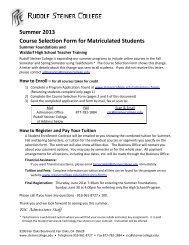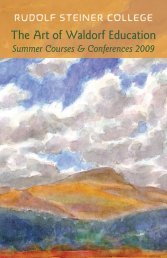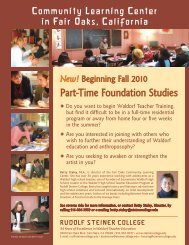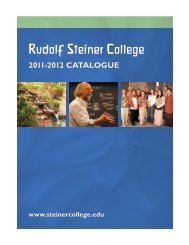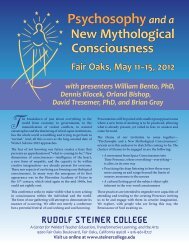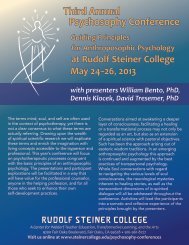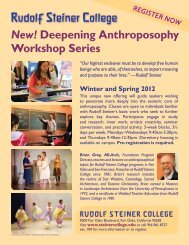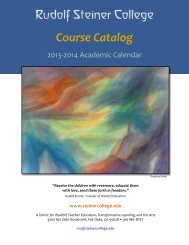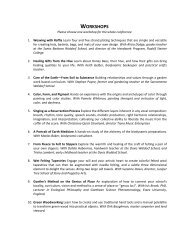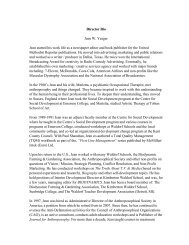Summer 2013 Course Descriptions and Schedules - Rudolf Steiner ...
Summer 2013 Course Descriptions and Schedules - Rudolf Steiner ...
Summer 2013 Course Descriptions and Schedules - Rudolf Steiner ...
You also want an ePaper? Increase the reach of your titles
YUMPU automatically turns print PDFs into web optimized ePapers that Google loves.
Table of ContentsSegment One—<strong>Summer</strong> Foundation <strong>Course</strong>s......................................................................................4Segment Two —High School Curriculum <strong>Course</strong>s...............................................................................12Segment Three—Adolescent Development.........................................................................................18Segment Four—Continuing <strong>Course</strong>work, Project, Mentoring <strong>and</strong> Field Experience........................20High School Teacher Training Faculty....................................................................................................212
Waldorf High School Teacher Training Program<strong>Summer</strong> <strong>2013</strong> <strong>Course</strong> <strong>Descriptions</strong> <strong>and</strong> <strong>Schedules</strong>The three-year Waldorf High School Teacher Training Program consists of three summer sessions(Segments One through Three) <strong>and</strong> two years of field experience, mentoring, <strong>and</strong> coursework (SegmentFour) during the fall <strong>and</strong> spring semesters. This program culminates at the end of the third summersession (there is no Segment Four in year three). At the completion of the program students will receive aWaldorf Teaching Diploma with a High School Emphasis.In this program students will participate in a journey of self-development, capacity building, <strong>and</strong>curriculum studies. Based on the spiritual scientific inspiration of <strong>Rudolf</strong> <strong>Steiner</strong> (1861-1925), the programis recognized in Waldorf schools worldwide. An M.A. program is also offered which incorporates the HighSchool Program.How to Apply1. Please fill out an RSC Program Application <strong>2013</strong>—14 (please note the instructions for new or returning students)2. Please fill out a High School <strong>Course</strong> Selection Form3. Please fax, email, or mail your completed forms it to the admissions office:<strong>Rudolf</strong> <strong>Steiner</strong> CollegeAdmissions Office9200 Fair Oaks BlvdFair Oaks, CA 95628Fax: 877-782-1884Email: rsc@steinercollege.eduFor more information <strong>and</strong> to obtain the above forms, please visit our website, www.steinercollege.edu, <strong>and</strong>navigate to the Admissions, How to Apply section. You may also contact the Admissions Office by calling916-961-8727 ext 100, or emailing rsc@steinercollege.edu.AuditorsTo register as an auditor, please fill out the Foundation <strong>and</strong> High School Curriculum Auditors <strong>Summer</strong><strong>2013</strong> <strong>Course</strong> Registration Form <strong>and</strong> fax, email, or mail it to the admissions office (details above). Do notregister online.Make-Up WorkIf you need to attend one or more classes from the <strong>Summer</strong> Foundation <strong>Course</strong>s for make-up work, pleasecontact Admissions to register <strong>and</strong> obtain a <strong>Course</strong> Make-Up Form by emailing rsc@steinercollege.edu or bycalling 916-961-8727 x100.Required ReadingFor a full book list, including recommended reading titles, please contact the Admissions office byemailing rsc@steinercollege.edu or by calling 916-961-8727 ext. 100.Program questions?Call Betty Staley, Program Director at 916-961 8727 ext. 101 oremail betty.staley@steinercollege.eduWaldorf High School Teacher Training Program3
Overview, Dates, <strong>Course</strong> <strong>Descriptions</strong> <strong>and</strong> <strong>Schedules</strong>Segment One - <strong>Summer</strong> Foundation <strong>Course</strong>sIdentify the Oaks or Cottonwood optionThe Oaks option4.5-week <strong>Summer</strong> session, includes Segments One through Four<strong>2013</strong> <strong>Summer</strong> session Dates: June 20—July 19, <strong>2013</strong>The Cottonwood option3-week summer session, includes Segments Two through Four (Foundation <strong>Course</strong>s must be completedalready or the student must be concurrently enrolled)<strong>2013</strong> <strong>Summer</strong> session Dates: June 30—July 19, <strong>2013</strong>Segment One—<strong>Summer</strong> Foundation <strong>Course</strong>swith director Astrid Schmitt-Stegmann<strong>2013</strong> Dates: Thursday June 20—Friday, 28 (no class on Sunday, June 23)Year One•Introduction to Waldorf Education I•Path of Self Knowledge-Introduction to Anthroposophy <strong>and</strong> the work of <strong>Rudolf</strong> <strong>Steiner</strong>-Nature of the Human Being I•Spiritual America•Self-Transformation through the Time Arts I-Eurythmy I, Music I, <strong>and</strong> Speech I•Self-Transformation through the Visual Arts I-Wet Method Painting<strong>Summer</strong> <strong>2013</strong> Details:Introduction to Waldorf EducationWith Lauren Hickman <strong>and</strong> Astrid Schmitt-StegmannThis course covers the basic view of child development <strong>and</strong> the Waldorf education <strong>and</strong> curriculum.Required reading: Education of the Child, <strong>Rudolf</strong> <strong>Steiner</strong>.<strong>Rudolf</strong> <strong>Steiner</strong>’s Life <strong>and</strong> Workwith Cynthia HovenBiographical overview of <strong>Steiner</strong>’s life, focusing on his contribution to the exploration of the supersensiblemeans of scientific discipline <strong>and</strong> the renewal of the arts. This course will include guests working with<strong>Rudolf</strong> <strong>Steiner</strong>’s indications in their professions.4
Nature of the Human Being Iwith Astrid Schmitt-StegmannThis course provides a basic underst<strong>and</strong>ing of the human being in body, soul, <strong>and</strong> spirit. Thisunderst<strong>and</strong>ing underlies our work as Waldorf teachers. In addition, there will be expansion of knowledgeprovided in the second chapter about considerations of karma <strong>and</strong> reincarnation. Required reading:Theosophy, Chapters 1—2, <strong>Rudolf</strong> <strong>Steiner</strong>.Spiritual America–Year 1, 2, <strong>and</strong> 3with Betty StaleyThis course introduces the student to the deeper meaning of America from a psychological <strong>and</strong> spiritualviewpoint. Using the Native American myth of Deganawidah (included in The American Soul) <strong>and</strong> examplesfrom 19th century American Transcendentalist writers, we will discuss the symbols <strong>and</strong> images <strong>and</strong> what theymean today. Required reading: The American Soul, Jacob Needleman; The Other America, Carl Stegmann.Eurythmy Iwith Cynthia HovenAn introduction to the movement art of eurythmy, the somatic component of the Waldorf curriculum. Focusis on developing spatial awareness <strong>and</strong> coordination, on harmonizing movement with feeling <strong>and</strong> thinking,<strong>and</strong> on cultivating social skills. Required reading: Eurythmy Movements <strong>and</strong> Meditations, Cynthia Hoven.Music Iwith Eva CranstounGroup singing <strong>and</strong> exploration of simple vocal techniques to improve sound quality <strong>and</strong> control. Basic musicskills like playing the recorder, reading sheet music, <strong>and</strong> underst<strong>and</strong>ing simple rhythms <strong>and</strong> intervals will beincluded. Required supplies: A soprano Yamaha plastic recorder which can be taken apart (alto recordersalso welcome). The Recorder Guide: An Instruction Method for Soprano <strong>and</strong> Alto Recorder Including Folk Melodies,Joanna E. Kulback <strong>and</strong> Arthur Nitka. Supplies available at the <strong>Rudolf</strong> <strong>Steiner</strong> College Bookstore.Speech Iwith Molly McIntyre LibbyThis course will concentrate on <strong>Rudolf</strong> <strong>Steiner</strong>’s exercises for developing one’s speech instrument for ahealthy physical <strong>and</strong> soul life. We will also work on a poem.Wet Method Paintingwith Ted MahleThis expressive technique is used in the Waldorf curriculum, yet can challenge even experienced artists. Wewill paint up to seven imaginative motifs including color studies, l<strong>and</strong>scapes, <strong>and</strong> the kingdoms of nature.Segment One - <strong>Summer</strong> Foundation <strong>Course</strong>s Training Program5
Year TwoSegment One - <strong>Summer</strong> Foundation <strong>Course</strong>s Training Program•Epistemology <strong>and</strong> Phenomenology-The Philosophy of Freedom I•The Path of Self-Knowledge-Nature of Human Being II (destiny <strong>and</strong> biography)-Inner Work•Spiritual America•Self-Transformation through the Time Arts II-Movement I, Music II, <strong>and</strong> Speech II-Self-Transformation through the Visual Arts II-Metamorphosis in Clay, H<strong>and</strong>work<strong>Summer</strong> <strong>2013</strong> Details:Philosophy of Freedom Iwith Brian GrayStudy of the first half of The Philosophy of Freedom, <strong>Steiner</strong>’s primary phenomenological exploration ofhuman consciousness. These chapters stimulate the reader to observe the living activity flowing through her/his perceiving <strong>and</strong> thinking, <strong>and</strong> to find there a firm basis for certainty in knowing the world. Required reading:Intuitive Thinking as a Spiritual Path (The Philosophy of Freedom, another translation), <strong>Rudolf</strong> <strong>Steiner</strong>.Nature of the Human Being IIwith Betty StaleyWe will explore the seven-year stages in adult life with reflective exercises <strong>and</strong> small group work. Requiredreading: Tapestries, second edition, by Betty Staley.Inner Workwith Astrid Schmitt-StegmannWe will work with the six basic exercises <strong>and</strong> the other suggested exercises as contemplative practice fromthe reading. Required reading: How to Know Higher Worlds, Chapters 1-5, <strong>Rudolf</strong> <strong>Steiner</strong>.Spiritual America–Year 1, 2, <strong>and</strong> 3with Betty StaleyThis course introduces the student to the deeper meaning of America from a psychological <strong>and</strong> spiritualviewpoint. Using the Native American myth of Deganawidah (included in The American Soul) <strong>and</strong> examplesfrom 19th century American Transcendentalist writers, we will discuss the symbols <strong>and</strong> images <strong>and</strong> what theymean today. Required reading: The American Soul, Jacob Needleman; The Other America, Carl Stegmann.Movementwith Cynthia HovenEurythmy from Year 1 continues.Music IIwith Eva Cranstoun6
Speech IIwith Molly McIntyre LibbyThis course will concentrate on <strong>Rudolf</strong> <strong>Steiner</strong>’s exercises for healthy breathing. We will also exploredifferent styles of poetry <strong>and</strong> how the breath is related to each style. We will sing as a group <strong>and</strong> exploresimple vocal techniques to improve sound quality <strong>and</strong> control. While learning to play the recorder,students will gain basic music skills such as reading sheet music <strong>and</strong> underst<strong>and</strong>ing simple rhythms <strong>and</strong>intervals. Required supplies: See Music Year 1 above.Metamorphosis in Claywith Patricia DicksonExploration of metamorphosis through either platonic solids, forming the capitals of the firstGoetheanum, or the seals designed by <strong>Rudolf</strong> <strong>Steiner</strong>.H<strong>and</strong>workwith Donna LoftusIntroduction to the h<strong>and</strong>work curriculum in the Waldorf school, including knitting.Year Three•Epistemology <strong>and</strong> Phenomenology-The Philosophy of Freedom II•Introduction to Waldorf Education II•Evolution of Consciousness <strong>and</strong> Culture-Cosmology-Philosophy, Karma <strong>and</strong> Reincarnation•Spiritual America•Self-Transformation through the Time Arts III-Eurythmy II, Movement II, Music III•Self-Transformation through the Visual Arts III-Veil PaintingSegment One - <strong>Summer</strong> Foundation <strong>Course</strong>s Training Program<strong>Summer</strong> <strong>2013</strong> Details:Philosophy of Freedom IIwith Brian GrayThis course will review <strong>and</strong> deepen underst<strong>and</strong>ing of The Philosophy of Freedom, further encouraging thereader to artistically apply her/his experiences to real, practical life – to discern which actions are felt to be “free”or “unfree”, <strong>and</strong> to rediscover one’s inner wellsprings of freedom <strong>and</strong> creative activity. Required reading: IntuitiveThinking as a Spiritual Path (The Philosophy of Freedom, another translation), <strong>Rudolf</strong> <strong>Steiner</strong>.Introduction to Waldorf Education II (Adolescence)with Betty StaleyWe will explore the development of the young person from age 14 – 21 <strong>and</strong> the Waldorf approach to thisage group. Required reading: Between Form <strong>and</strong> Freedom, Betty Staley.7
Segment One - <strong>Summer</strong> Foundation <strong>Course</strong>s Training ProgramCosmologywith Cynthia HovenWe will explore <strong>and</strong> examine the interplay of correspondences that <strong>Rudolf</strong> <strong>Steiner</strong> develops betweenmicrocosm <strong>and</strong> macrocosm, between the evolution of the human being <strong>and</strong> the evolution of the cosmos,making the human reality a cosmic reality in constant becoming. The course requires a knowledge of thehuman constitution as it is developed in the required reading before the course begins. Required reading:Founding a Science of the Spirit, Chapters 1, 9, 10 <strong>and</strong> 11, <strong>Rudolf</strong> <strong>Steiner</strong>.Karma <strong>and</strong> Reincarnationwith Brian GrayWe will explore <strong>Steiner</strong>’s spiritual scientific insights into the nature of repeated earth lives <strong>and</strong> karma.Working with these insights can lead to an ennoblement of the human soul, calling forth compassion <strong>and</strong>love for others <strong>and</strong> the kingdoms of nature <strong>and</strong> the awakening of individual initiative toward freedom,creativity, <strong>and</strong> active responsibility. Required reading: Manifestation of Karma, <strong>Rudolf</strong> <strong>Steiner</strong>.Spiritual America–Year 1, 2, <strong>and</strong> 3with Betty StaleyThis course introduces the student to the deeper meaning of America from a psychological <strong>and</strong> spiritualviewpoint. Using the Native American myth Deganawidah ( included in The American Soul) <strong>and</strong> examplesfrom 19th century American Transcendentalist writers, we will discuss the symbols <strong>and</strong> images <strong>and</strong> what theymean today. Required reading: The American Soul, Jacob Needleman; The Other America, Carl Stegmann.Eurythmy IIwith Cynthia HovenA second-level course in eurythmy, building upon experiences developed in Eurythmy I. Participantswill work with language <strong>and</strong> poetry experiences. Required reading: Eurythmy Movements <strong>and</strong> Meditations,Cynthia Hoven.Music IIIwith Eva CranstounGroup singing <strong>and</strong> exploration of simple vocal techniques to improve sound quality <strong>and</strong> control. Basicmusic skills such as playing the recorder, reading sheet music, <strong>and</strong> underst<strong>and</strong>ing simple rhythms <strong>and</strong>intervals will be included. This builds on Music II.Veil Paintingwith Ted MaheThrough first building up a color “atmosphere,” we will discover how form <strong>and</strong> a motif can graduallyemerge out of the world of color. Artistic <strong>and</strong> practical, challenging <strong>and</strong> inspiring, we develop ourselves aswe develop our art.8
Segment One, Year 1 ScheduleSegment One - <strong>Summer</strong> Foundation <strong>Course</strong>s Training Program9
Segment One, Year 2 ScheduleSegment One - <strong>Summer</strong> Foundation <strong>Course</strong>s Training Program10
Segment One, Year 3 ScheduleSegment One - <strong>Summer</strong> Foundation <strong>Course</strong>s Training Program11
Segment Two - High School Curriculum <strong>Course</strong>sSegment Two—High School Curriculum <strong>Course</strong>swith Program Director, Betty Staley<strong>2013</strong> Dates: Orientation—Sunday, June 30, <strong>2013</strong>Classes—Monday, July 1 through Friday, July 12(no class on the Saturday <strong>and</strong> Sunday in between)<strong>2013</strong>—Focus on Grades 9 <strong>and</strong> 10•Grades Nine <strong>and</strong> Ten Seminar•Knowledge of the Human Being I, II, or III•Curriculum Studies I-English, History, Physics, Chemistry, Spanish, Mathematics, Art•The Time Arts-Eurythmy, Speech•Elective Art I•Inner development of a high school teacher.2014—Focus on Grade 11•Grade Eleven Seminar•Knowledge of the Human Being I, II, or III•Curriculum Studies II-English, History, Physics, Chemistry, Spanish, Mathematics, Art•Time Arts-Eurythmy, Speech•Elective Art II•Governance in a Waldorf School2015—Focus on Grade 12•Grade Twelve Seminar•Knowledge of the Human Being I, II, or III•Curriculum Studies III-English, History, Physics, Chemistry, Spanish, Mathematics, Art•Time Arts-Eurythmy, Speech•Elective Art III•Communication Skills<strong>Summer</strong> <strong>2013</strong> Details:Opening Talk:by Dr. Allegra Aless<strong>and</strong>ri“One Person, Two Journeys: Founding an Independent Waldorf High School <strong>and</strong> a Public Waldorf-Inspired High School”.12
Morning <strong>Course</strong>sKnowledge of the Human BeingInstructors: Year 1 students will be with Anouk Tompot; Year 2 students with Betty Staley; <strong>and</strong> Year3 students with Patrick Wakeford-Evans.This course covers the threefold nature of the human being including the 12 senses, nervous, rhythmic<strong>and</strong> metabolic systems, <strong>and</strong> thinking, feeling, <strong>and</strong> willing. This course is taken over 3 years, each yearfocusing on a third of the book. Required reading: The translation entitled Study of Man by <strong>Rudolf</strong> <strong>Steiner</strong>is preferred to the newer translation entitled Foundations of Human Experience.9th/10th Grade CurriculumEnglish with John WulsinWeek 1: 9th grade course focuses on 2 key Main Lessons: “Comedy <strong>and</strong> Tragedy” through the polaritiesof Apollo <strong>and</strong> Dionysus, <strong>and</strong> “The Novel” through the study of Moby Dick.Week 2: 10th grade course emphasizes the epic quality of 10th grade. The Main Lesson entitled “The Artof Poetry” combines elements of poetry with the evolution of the English language. <strong>Course</strong> also exploresthe Bible as a major source of global imagination.Mathwith Lisa BabinetWeek 1 <strong>and</strong> 2: Mathematics in the 9th <strong>and</strong> 10th grades. Mornings include heavier emphasis on algebraicwork <strong>and</strong> numerical calculations, while afternoons emphasize geometry. Additional topics may includecombinatorics, quadratic equations trigonometry, conic sections, <strong>and</strong> a calculation of pi. Anecdotal topicsof relevant mathematical interest to the participants will also be addressed.Historywith Betty Staley, Paul Gierlach, <strong>and</strong> Diamela WetzlWeek 1: 9th grade: Explores revolutions, including economic, political <strong>and</strong> cultural factors for 3 days. Forthe 2 following days, discussions of Paul Gierlach’s course “Individualism <strong>and</strong> Humanity” will be studied.Week 2: 10th grade: Reviews Ancient Civilizations of Mesoamerica <strong>and</strong> South America.Also covers Ancient Civilizations of Mesoamerica <strong>and</strong> South America from 3000 BCE to the 15thCentury CE, the period of explorations, discovery <strong>and</strong> colonization by the Spanish Crown <strong>and</strong> otherpowers of post Renaissance Europe. The geography, social structures (everyday life of the indigenouspeople), governments, religions, <strong>and</strong> science are also included. The richness of the arts are examinedspanning building, to pottery, to weaving, to painting <strong>and</strong> then to metallurgy. Also explored are theamazing capacities for community-building of the peoples of the Maya, Teotihuacan, Toltec-Aztec <strong>and</strong> IncaCivilizations of ancient America.Spanishwith Diamela WetzlWeek 1: 9th <strong>and</strong> 10th grade overview of the high school Spanish curriculum, integrating language study <strong>and</strong>culture, including an underst<strong>and</strong>ing of how the study of Spanish can support the development of the adolescent.Week 2: Spanish students take the Meso-American History course.Segment Two - High School Curriculum <strong>Course</strong>s13
Segment Two - High School Curriculum <strong>Course</strong>sLife Sciencewith Anouk TompotWeek 1: 9th grade course covers human biology <strong>and</strong> anatomy. Using the three-fold human body asa theme, the skeleton, skin, limbs, muscles, heart <strong>and</strong> rhythmic systems will be explored via lectures,discussions <strong>and</strong> lab exercises.Week 2: 10th grade course includes human biology <strong>and</strong> physiology. Again using the three-fold humanbody as a theme, the processes <strong>and</strong> relationships between the digestive system, blood, brain, endocrinesystem, <strong>and</strong> the reproductive system will be studied.Physicswith John PeteringWeek 1: 9th grade course includes electricity, magnetism, heat studies, <strong>and</strong> applications in engines.Week 2: 10th grade course includes motion <strong>and</strong> mechanics. Suggested reading: Fundamentals for aPhenomenological Study of Chemistry, chapters 3-5, by Fritz Julius. Prerequisites: Basic familiarity withcollege physics <strong>and</strong> the Goethean approach to science.Artswith Van JamesWeek 1: 9th grade “History of Art”. Art appreciation facilitates the important rite of passage for theadolescent. The balancing effect of aesthetic awareness, how humanity’s sense of beauty has changed overthe course of time, brings strength <strong>and</strong> perspective to the young person at this stage of their development.Week 2: 12th grade “History of Architecture”. Due to instructor availability this 12th grade class is beingoffered this summer. <strong>Course</strong> will explore some of the important themes that thread through the history ofarchitecture <strong>and</strong> their relevance for high school seniors.Seminar (Grades 9 <strong>and</strong> 10):With Betty Staley, Paul Gierlach, Molly McIntyre Libby, Alice Stamm, <strong>and</strong> High School FacultyWeek 1: Begins with 30 minutes of Speech followed by faculty presentations on the characteristics of 9thgraders. Opportunities for questions regarding student holistic support will be provided.Week 2: Begins with 30 minutes of Eurythmy followed by faculty presentations on how their subject areameets 9th <strong>and</strong> 10th graders in their development.Afternoon <strong>Course</strong>s9th/10th Grade Curriculum (continued)English (continued)with John WulsinWeek 1: 9th grade content includes vocabulary, grammar, speech, other reading <strong>and</strong> writing, such asjournals, essays, poetry.Week 2: 10th grade content includes vocabulary, grammar, writing short stories, a class play, <strong>and</strong> The Odyssey.Math, (continued) with Lisa Babinet14
Historywith Nicole FieldsWeek 1: 9th Grade. Native American History. Native American culture is explored spanning myth tomigration theories through to the modern era. <strong>Course</strong> covers the many waves of European arrivals, theestablishment of the U.S. <strong>and</strong> how these changes affected native lives <strong>and</strong> populations.Week 2: 10th grade. Ancient History from India to Greece. <strong>Course</strong> explores the ancient world <strong>and</strong> itsimportance as a basis for western civilization. Students participate in lecture, discussion, <strong>and</strong> their ownpresentations of the highlights of this cornerstone course.Spanish (continued)with Diamela WetzlChemistrywith John PeteringWeek 1: 9th Grade Chemistry topics include photosynthesis, carbohydrates, alcohols, carboxylic acids<strong>and</strong> essential oils. Students will examine chemical qualities, occurrence in nature, <strong>and</strong> role in our lives ofthe aforementioned topics.Week 2: 10th Grade Chemistry will include salts, acids bases, acid-base reactions <strong>and</strong> stoichiometry, as wellas oxidation/reduction in electrochemical cells. The class as a whole group creates a detailed outline forthis block, <strong>and</strong> work through the design of several student experiments. Suggested reading: Fundamentalsfor a Phenomenological Study of Chemistry, chapters 3-5, By Fritz Julius. Prerequisites: Basic familiaritywith college physics <strong>and</strong> the Goethean approach to science.Artswith Van JamesWeek 1: 9th grade “History of Art”. Continues in the afternoon.Week 2: 12th grade “History of Architecture”. Continues in the afternoon.Segment Two - High School Curriculum <strong>Course</strong>sArts Elective <strong>Course</strong>sStudio Drawing <strong>and</strong> Paintingwith Van JamesWeeks 1 <strong>and</strong> 2: The 9th grade studio drawing course explores the transition from black <strong>and</strong> whitedrawing, light <strong>and</strong> dark effects <strong>and</strong> the shaping of interior spaces. The 10th grade studio painting coursehighlights the earthy Dutch palette of colors <strong>and</strong> atmospheric effects.Metamorphosis in Claywith Patricia DicksonWeeks 1 <strong>and</strong> 2: Explores embryology through clay modeling as well as other examples of metamorphosis.Crafts with Carol CliftonWeeks 1 <strong>and</strong> 2: As in the history of textile technology basketry precedes weaving, so it does in theWaldorf 9th grade curriculum. Using rattan reed <strong>and</strong> techniques based on the Cherokee style of basketweaving, each student designs his/her on basket, taking into account function, size, shape <strong>and</strong> patterning.Four Harness Loom Weaving follows in the 10th grade where students experience designing, warping <strong>and</strong>weaving cloth on four-harness loom <strong>and</strong> are encouraged to explore the various possibilities in pattern <strong>and</strong>design with a simple twill pattern.15
Segment Two - High School Curriculum <strong>Course</strong>sEvening <strong>Course</strong>sInner Development of the High School Teacherwith Betty StaleyRequired Reading: Lighting Fires, Deepening Education through Meditation, by Jorgen Smit.Segment Two, Year 1, 2 <strong>and</strong> 3 Schedule16
Segment Three—Adolescent Developmentwith Program Director Betty Staley<strong>2013</strong> Dates: Monday, July 15 through Friday, July 19<strong>2013</strong>—Focus on Grades 9 <strong>and</strong> 10Physiological <strong>and</strong> Emotional DevelopmentTime ArtsMusic, EurythmyMethods I (Biography)2014—Focus on Grade 11Gender IssuesTime Art- MusicEurythmy, Speech, DramaMethods II (Life Processes)2015—Focus on Grade 12Cognitive DevelopmentMusic, Eurythmy, Spacial DynamicsMethods III (Lesson Planning)Segment Three - Adolescent Development<strong>Summer</strong> <strong>2013</strong> Details:Exploring Identity: Gender, Sexuality, Emotional skillswith Betty Staley <strong>and</strong> Megan SullivanAs adolescents are forming their sense of identity, the pressures on them from society are the strongest. Howcan teachers help teens develop a healthy sense of self so they can nurture their ideals <strong>and</strong> prepare for theiremerging personality? The masculine <strong>and</strong> feminine journey through contemporary writings <strong>and</strong> approachesto sex education are examined via study of Lecture Five of <strong>Rudolf</strong> <strong>Steiner</strong>’s Education for Adolescence.Required reading: Boys <strong>and</strong> Girls Learn Differently, by Michael Gurian; Adolescence, the Sacred Passage by BettyStaley. This course includes daily work in Speech with Molly McIntyre Libby, Singing with Eva Cranstoun,<strong>and</strong> Eurythmy with Alice Stamm as opportunities of transformation for the teacher.Curriculum <strong>and</strong> Instruction I: Developing Effective Presentations inTransformative Performing Arts<strong>Course</strong> includes emphasis on narration with an emphasis on biography. Each student will present atwenty-minute biography related to his/her specialty subject.Transformative Performing ArtsSpeechwith Molly McIntyre LibbySingingwith Eva CranstounEurythmywith Alice Stamm17
Segment Three, Year 1, 2 <strong>and</strong> 3 ScheduleSegment Three - Adolescent Development18*Please Note: All schedules are subject to change. Final schedules will be available at registration.
Segment Four—Continuing <strong>Course</strong>work, Project, Mentoring <strong>and</strong>Field Experience (Year 1 <strong>and</strong> 2 students only)with various faculty<strong>2013</strong>–14 Dates: TBD*Full details for Segment Four coursework will be provided during the <strong>Summer</strong> sessionResearch, Observation <strong>and</strong> Field ExperienceIncludes continuing coursework from summer curriculum courses, independent study, mentoring, <strong>and</strong> fieldexperience.Years 1, Fall•Curriculum courses continuing coursework¯Independent study, online coursework, etc.•MentoringYear 1, Spring•Curriculum courses continuing coursework¯Independent study, online coursework, etc.•Field Experience IYears 2, Fall•Curriculum courses continuing coursework¯Independent study, online coursework, etc.•Field Experience IIYear 2, Spring•Curriculum courses continuing coursework¯Independent study, online coursework, etc.•Curriculum Project•Research ProjectA Note for Year 3 Students:This program culminates with the completion of the third summer session (<strong>and</strong> all related coursework). YearThree does not include Segment Four. Due to the program redesign, <strong>2013</strong>-14 Year Three students may haveadditional requirements to complete the program as authorized by the Program Director, Betty Staley.Program DirectorBetty Staley, MA, directs the Waldorf High School Teacher Training Program. A Waldorf educator forover thirty years at the kindergarten, elementary, high school <strong>and</strong> teacher training levels, she is a founderof the Sacramento Waldorf High School where she taught history <strong>and</strong> literature for nineteen years. She isan international lecturer <strong>and</strong> consultant, <strong>and</strong> is one of the founders of <strong>Rudolf</strong> <strong>Steiner</strong> College. Betty hasalso authored six books, including, Between Form <strong>and</strong> Freedom: A Practical Guide to the Teenage Years; Hearthe Voice of the Griot!: A Guide to the History, Geography <strong>and</strong> Culture of Africa; Tapestries: Weaving Life’s Journey;<strong>and</strong>, Adolescence: The Sacred Passage, Inspired by the Legend of Parzival.High School Pedagogical Advisory TeamDr. Allegra Aless<strong>and</strong>ri, Dr. Lisa Babinet, <strong>and</strong> Anouk Tompot.Segment Four - Continuing <strong>Course</strong>work, Project, Mentoring <strong>and</strong> Field Experience19
High School Teacher Training Faculty20High School Teacher Training FacultyCarol Clifton, BS- Ed in Mathematics, Ph.D. U. of Pa. Science education10 years San Juan Adult Ed program, 36 years at SWS H<strong>and</strong>work teaching.Lisa Babinet, M.A., Ph.D.Science education. Taught in U. of Pa. Graduate School of Education 10 years, formerly Dean of Students,Crystal Springs Upl<strong>and</strong>s School, Member of High School Leadership Team <strong>and</strong> teacher of math, WaldorfSchool of the Peninsula, Teaching math since 1980.Eva CranstounPrivate music <strong>and</strong> vocal studies in Vienna, Austria; <strong>Rudolf</strong> <strong>Steiner</strong> College Teacher Training graduate;Uncovering the Voice vocal training with Christiaan Boele; Singing therapy diploma; music director atStonebridge School in Napa, California.Patricia Dickson, MA*Member of <strong>Rudolf</strong> <strong>Steiner</strong> College arts faculty <strong>and</strong> administrator of Waldorf Subject Teacher Program.Nicole FieldsH<strong>and</strong>work teacher at the Sacramento Waldorf School.Waldorf High School Teacher Education Certificate,<strong>Rudolf</strong> <strong>Steiner</strong> College; formerly Humanities <strong>and</strong> Arts teacher at the Sacramento Waldorf School.Molly McIntyre Libby, MSMasters in Communication Disorders. Diploma from the Speech School <strong>and</strong> the Sunbridge CollegeRemedial Program.John Petering, MS25 years teaching natural science at Waldorf high schools in Boulder <strong>and</strong> Detroit; currently teaching atSacramento Waldorf School.Betty Staley, MA*Director of <strong>Rudolf</strong> <strong>Steiner</strong> College Waldorf High School Teacher Education Program; over 30 yearsexperience as a Waldorf high school teacher; founder of the Sacramento Waldorf High School;international lecturer <strong>and</strong> consultant; <strong>and</strong> author of six books including Splinters of the Sun: TeachingRussian Literature to High School Students.Alice StammAlice Stamm has been teaching eurythmy since 1975; she began her eurythmy training in Eckwalden,Germany <strong>and</strong> finished with Else Klink in Stuttgart. She also trained in therapeutic eurythmy, receiving adiploma from the Goetheanum in Dornach Switzerl<strong>and</strong>.Anouk Tompot, M.A. University of Amsterdam, BiologyUniversity of Amsterdam, Biology. Taught Life Science at Denver Waldorf School <strong>and</strong> now at SeattleWaldorf School. Teaches at Sound Circle Waldorf Teacher Training program. Alum of RSC High SchoolTeacher Training Program.Diamela WetzlWaldorf Spanish teacher in the grades <strong>and</strong> high school for 32 years; mentor to Spanish teachers.John Wulsin, AB Harvard, Emerson College Waldorf Training, MA English, Columbia U.,Thirty-one years teaching at Green Meadow Waldorf School, author of several books on English language<strong>and</strong> the transcendentalists.*<strong>Rudolf</strong> <strong>Steiner</strong> College Core Faculty. Updated 4/9/<strong>2013</strong>



